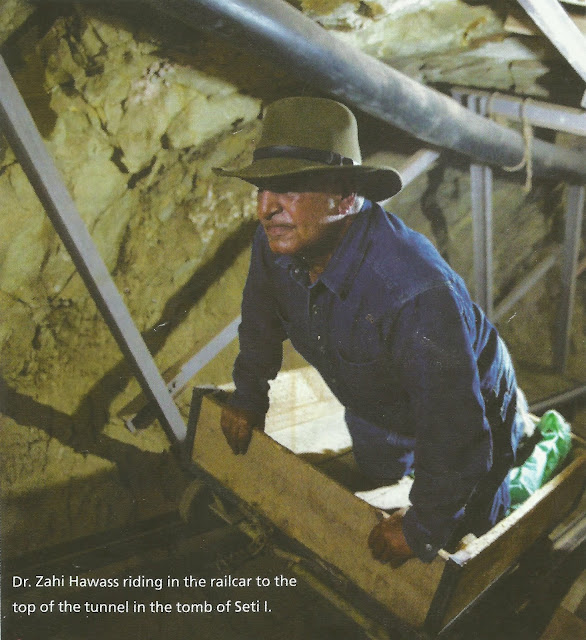New Discoveries in Ancient Thebes
Luxor has more and more secrets to tell
Written by and
photos courtesy of Dr. Zahi Hawass
New and important discoverieskeep emerging from the sands of
Egypt. Many of these come from Luxor, known in ancient times as “Thebes', where
recent work by an Egyptian team of archaeologists is revealing extraordi* nary
material that adds to our under standing of the Golden Age of Egypt, the New
Kingdom, during King Tutankhamun's reign.
Foundation Deposits in the Valley of the Monkeys
Since 2007, I have been leading the first-ever allEgyptian
archaeological team to excavate in the Valley of the Kings. I have dreamed of
such an expedition since I was a young inspector with a
foreign team that was working on the west bank of Luxor. I
wrote some articles for Horus magazine about the amazing artifacts that we have
found. However, new discoveries emerge! Most recently, our team has
uncovered four intact foundations deposits in the so-called
'Valley of the Monkeys', which is one term for the western arm of the canyons
that make up the Valley of the Kings. These deposits, which would have been
buried as part of the dedication of a new tomb, include pottery, weapons,
tools, animal bones, and other artifacts. It is clear that they were buried as
associated with a royal tomb, most likely of the late 18th Dynasty. This
opinion is based on the style of the artifacts, specifically the blue pottery
dated to the reign of Amenhotep III. They were found near the tomb of the
Pharaoh Ay, successor to Tutankhamun. Egyptologists believe that when he became
king, Ay, who was then an elderly man, married Tutankhamun's widow,
Ankhsenamun, to secure his claim to the throne. I believe that Ankhesenamun's
tomb is located in the Valley of the Monkeys, near that of her last husband,
and that these deposits may mark its location.
The Tunnel of Seti I
Another major project on which my team has been working in
the Valley of the Kings is the excavation of the mysterious tunnel that leads
from the burial chamber in the tomb of Seti I far back into the cliffs behind.
This was first discovered in October, 1817 by the colorful Italian explorer and
engineer, Giovanni
Belzoni, who was the first man to enter this fabulous royal
tomb in modern times. However, he only penetrated a short distance into the
tunnel. Howard Carter, who was later to go on to discover Tutankhamun's tomb,
restored the entrance to this passageway in 19021903, while he was serving as
Chief Inspector of Upper Egypt. Nonetheless, he and his team were not able to
go very far inside due to the danger of rock falls. In 1960, the
Abdel-Rassouls, a local family well-versed in exploring the secrets of the Theban
hills (famous, in fact, for discovering a cache of royal mummies - including
that of Seti I - in the late 1800s), received permission to work in this
tunnel, excavating 136 meters of its length before they gave up, again because
of the danger of falling rock. The leader of this expedition, Sheikh Ali
AbdelRassoul, told me about that adventure before he died, and encouraged me to
continue exploring the tunnel as soon as I could. He was sure that there were
great discoveries to be made here. Besides, he was certain that I was the one
who would make them.
Egyptologists have long debated the purpose of this tunnel,
with the majority believing that it was a symbolic structure connected with the
route the deceased king would follow on his way through the underworld,
traveling from death to resurrection. On the other hand, Sheikh Ali believed
that it led to the real burial chamber of the king, and might still be full of
treasures.
My team and I began our work in the winter of 2007. Over the
course of two and a half years of excavations we have been able to reveal the
tunnel's secrets. First, we carefully studied the geologic composition of the
tunnel walls, so that
we could do our best to make sure that our work would be
safe. Only then did we begin to excavate, clearing debris from the tunnel. As
we worked our way into the downward-sloping passageway, we constructed a
framework of steel beams to support the ceiling, and a small railway to
transport the sand and stone rubble from the excavations backup to the surface.
This railway came in handy in many ways as the work progressed; I even used it
myself to get in and out of the tunnel! We also built awooden staircase so that
the excavation the excavation team could climb up and down to the excavation
site.“
When we reached the part of the
tunnel where the Abdel-Rassouls had stopped their work, we
realized that they had begun to diverge from the real route of the ancient
passageway. That's why we shifted our course so that we could be back on the
correct path. As we cleared the debris in this previously untouched area, we
uncovered a number of interesting artifacts, including pottery sherds, two
royal shabtis, a small
faience boat, and several inscribed stone
fragments bearing the name of Seti I. At approximately 140 m. from the
entrance team found three rock cut steps, each about 2.6 cm wide. Thiswas
an amazing moment! We were all very excited at this new discovery. We
continued, and found more and more steps - they were 54 in
total. What we had uncovered looked just like the sort of stairway that
typically leads down to a royal tomb!
Enthusiastically we continued our work, and began to uncover
a second corridor cut from the rock, again with a carefully smoothed floor. On
the walls of the first descending passage there was a rock-cut gate with a
hieratic (cursive) inscription that reads: "Raise up the door jamb up and
widen the passage!" - That was clearly directions to the workmen cutting
the tunnel. As we removed the sand and debris from the new corridor we could
see that gridlines had been drawn on its left wall, in preparation for some
sort of decoration. My assistant, Tarek El-Awady, and I began to believe that
Seti I had been building a tomb within a tomb. After that incident I began to
visit Luxor more often, and checked with my team every hour when I was away.
Fortunately, another surprise was in store: my team found a
second set of
stairs at the end of the new corridor. This new one
consisted of 37 steps, with the final step left unfinished. Only one meter beyond
this, 174.5 meters from the entrance, the tunnel ended in a blank wall. Based
on our study of the unfinished step and the end of the tunnel, we theorized
that while the workmen were just finishing the staircase they were informed of
King Seti I's death, so they immediately stopped their work. Upon reaching the
end of the tunnel and seeing the unfinished work, I was sure that the tunnel
was originally meant to be a tomb within a tomb. Due to Seti I's death, his
tunnel was never finished.
I was so happy that we were able to : reach the end of the
tunnel, and uncov- er all of its secrets. On the last day of the excavation, I
was down at the tun-> nel, sitting at the bottom of the second set of stairs
and staring at the dead end that lay only a meter away. “This is a wonderful
moment to enjoy,", I thought, 'having found the end of the tunnel, but if
Sheikh Ali were here, he would be
very unhappy that no golden treasures were found inside', .
I was also too tired to move. Therefore, I asked Tarek to help me get inside
one of the railcars so that I could go back to the top. The excitement of
discovery can also be physically exhausting!
The Tomb of Ramesses II
Seti I's son and successor, Ramesses II ("Ramesses the
Great") ruled Egypt for 66 years. After uncovering Seti I's tunnel, we
began to wonder whether his son might not have carved a similar structure
within his own tomb; and since he reigned for so long, perhaps he had enough
time to finish it. Finding a complete example would tell us more about the
nature of Seti I's tunnel, and help us solve this ancient mystery.
Unfortunately, however, Ramesses II's tomb is in terrible condition, as many
flash floods washed through it over the millennia and filled it with debris.
Thus we are now completing major restoration work here, before we can search
for a possible tunnel inside.
Several new chapters have been added to the archaeological
story of Luxor in recent years. The discovery of foundation deposits in the
Valley of the Monkeys, may lead to a new tomb, perhaps belonging to
Ankhesenamun. The most exciting part of Luxor's archaeological tale is that I
was finally able to solve the mysteries about the tunnel of Seti I. The
mysterious Luxor has many stories to tell! One of these tales is the salvage
archaeological campaign on the Avenue of the Sphinxes, located between Luxor
and Karnak temples. It is my hope it will be just as successful as the
excavations in the Valley of the Monkeys and the Valley of the Kings.








No comments:
Post a Comment